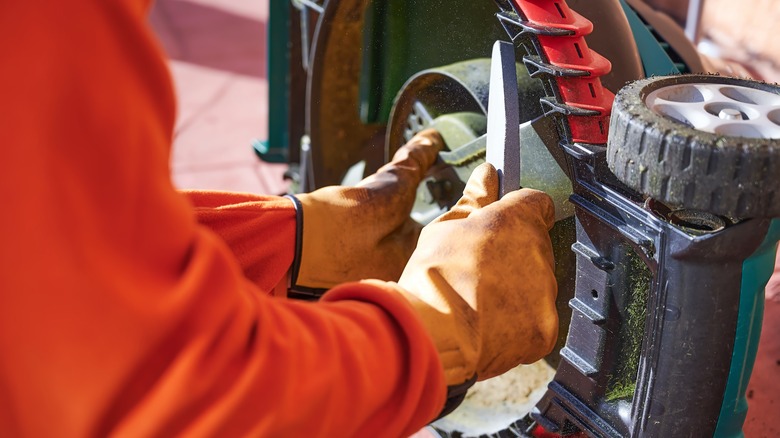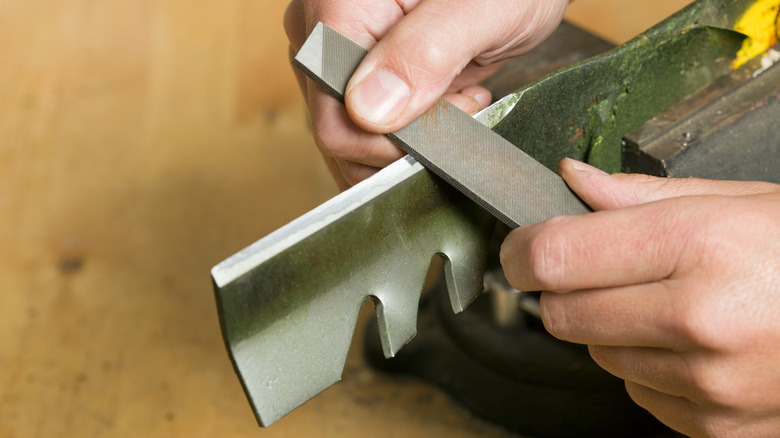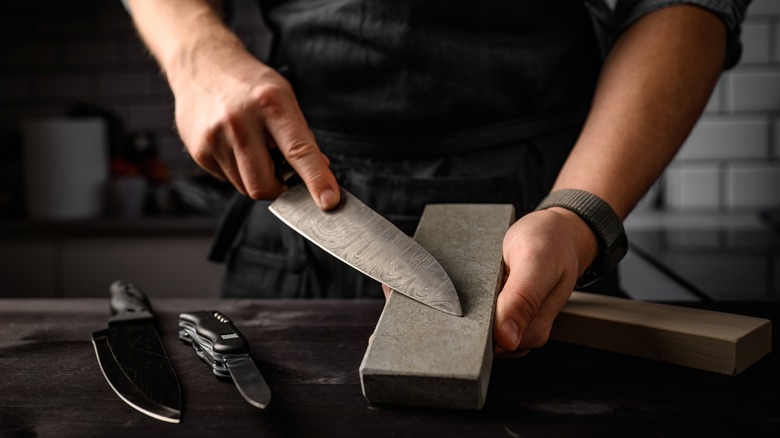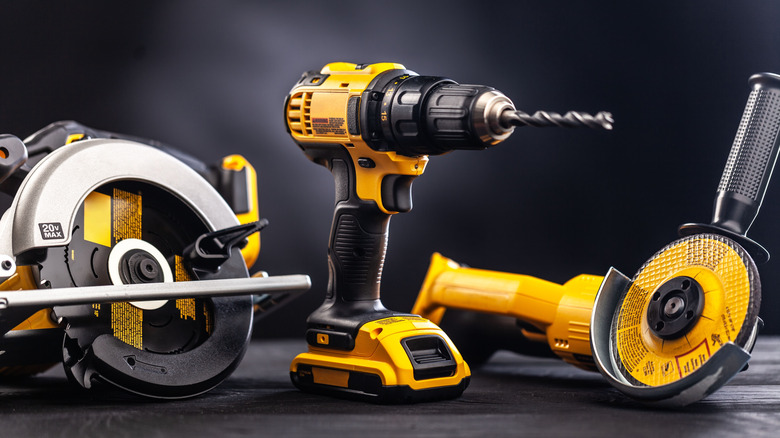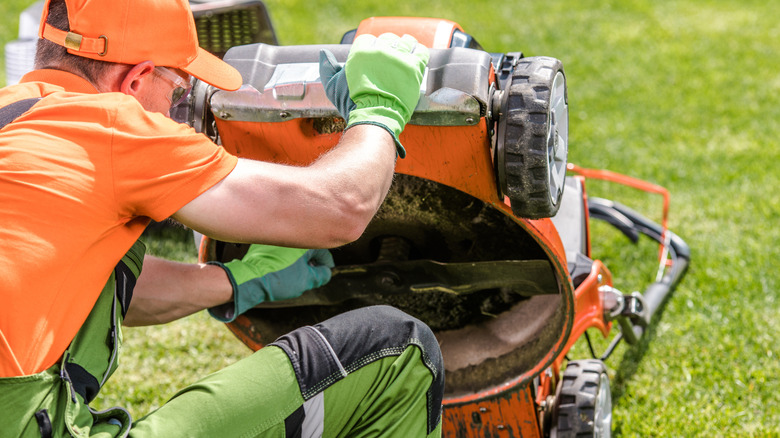Different Ways To Sharpen Your Lawn Mower Blades
Maintaining sharp lawn mower blades is not merely a myth of lawn care practices; it's a fundamental aspect that directly impacts the health and appearance of your lawn, much like regular watering or fertilizing. Dull blades have the potential to tear rather than cleanly cut grass blades, leaving behind jagged edges that are more susceptible to disease and discoloration — certainly not something your neighbors will admire about your yard.
Whichever method you choose, before getting to the sharpening bit, it's crucial to prepare yourself and your blades properly. For your safety, be sure to wear heavy-duty gloves to shield your hands from sharp edges. As well, don safety glasses to protect your eyes from sparks, debris, and metal filings generated during the sharpening process. Then, disconnect the spark plug to prevent accidental starts. Position your mower on a stable, level surface and utilize a wrench to carefully remove the blades from the mower deck, noting their orientation with a marker for seamless reinstallation later. Once detached, dedicate ample time to thoroughly cleanse the blades, eliminating any accumulated grass, dirt, or debris that could impede the sharpening process. This preparatory step not only enhances the effectiveness of the sharpening procedure but also prolongs the longevity of your mower blades, ensuring optimal performance during each mow.
Now, let's delve into the different sharpening methods available. Whether you're a seasoned lawn care enthusiast or a novice homeowner looking to improve your mowing routine, these sharpening techniques will help you achieve professional-quality results without incurring their cost.
A grinder
Using a grinder to sharpen lawn mower blades is an efficient method for maintaining a sharp cutting edge. Two main types of grinders are commonly used: angle grinders and bench grinders.
Angle grinders are handheld power tools equipped with a rotating abrasive disc. They are ideal for sharpening lawn mower blades because they are mobile and can be used in a variety of spaces, whether outdoors or in your garage. To use, hold the angle grinder with both hands and position the grinding disc at an angle to the blade's cutting edge. Apply gentle pressure and move the grinder along the cutting edge in smooth, even strokes. Maintain a consistent angle to ensure an even sharpening across the entire length of the blade. This method requires extremely steady hands for even sharpening, so if you find this difficult or daunting, this may not be for you.
Bench grinders, on the other hand, are stationary tools mounted on a bench or pedestal, providing stability and precision. When using a bench grinder, adjust the tool rest to the desired angle, typically around 30 degrees, and ensure the grinder is properly anchored to the workbench. Turn on the grinder and wait for it to reach full speed before bringing the blade into contact with the grinding wheel. Hold the blade against the tool rest and move it across the grinding wheel in a smooth, controlled motion. Turn off the grinder and inspect the blade periodically to check for sharpness and consistency.
By hand using a file
If you don't have power tools at home, using a file provides a hands-on approach to sharpening lawn mower blades. Various types of files are available, each serving specific sharpening needs. Flat files, for example, excel in maintaining the existing angle of the blade's cutting edge, ensuring consistency and accuracy in sharpening. On the other hand, mill files are more aggressive and can efficiently remove larger amounts of material, making them ideal for blades with significant dullness or damage.
To begin sharpening with a file, securely clamp the blade in a vise or to the edge of a workbench to prevent movement and ensure stability during the sharpening process. Hold the file at a 45-degree angle and move it along the blade's edge in one direction. Each stroke will remove excess or blunted metal from the side of the blade. Once you've sharpened one side, flip over and repeat for the other side until you've reached your desired sharpness. In order to ensure congruence, Bob Vila suggests counting your strokes to ensure that you apply consistent processes to both sides of the blade.
While using a file can be effective for many, however, it may not be suitable for everyone. Speaking from personal experience, individuals who lack the physical strength or dexterity to securely clamp the blade in place and simultaneously maneuver the file with precision may find this method challenging.
By hand using a stone
For traditionalists, sharpening lawn mower blades by hand with a sharpening stone can be an effective method. Sharpening stones come in various grits and materials, allowing users to choose the appropriate one for their sharpening needs. Water stones, diamond stones, and oil stones are the three most common types, each offering unique advantages. Water stones are softer than oil stones due to the binder that holds the abrasives together, promoting faster cutting. Diamond stones are renowned for their exceptional hardness and cutting speed, while oil stones offer durability and reliability.
To sharpen a blade with a sharpening stone, clamp your blade in securely. Then, hold the stone firmly and position it against the cutting edge of the blade at your desired angle. Apply light to moderate pressure and move the stone along the cutting edge of the blade. After several strokes, flip the blade over and repeat the sharpening process on the opposite side to ensure even sharpening and maintain the correct bevel.
For a finer edge, finish the sharpening process by using a finer gritstone to hone and polish the blade. This step helps refine the edge and remove any remaining burrs, resulting in a razor-sharp finish.
A power drill
According to Joe from Joe's Lawn Care, "There's nothing more fun to use than a power drill." A power drill equipped with a sharpening attachment offers a convenient and efficient method for sharpening lawn mower blades.
Sharpening attachments typically include grinding or sharpening wheels specifically designed for metal sharpening tasks. If you are seeking a balance between efficiency and control, this tool is ideal for those who want to streamline the sharpening process without sacrificing precision.
To sharpen the blade using a power drill, attach the sharpening tool and secure the blade in a vise or clamp to prevent movement. Turn on the power drill and position the sharpening attachment against the back of the blade. This will help guide you as to the correct angle from which to cut the edge of the blade. Once positioned,
move the attachment along the blade's edge in smooth, controlled motions, applying gentle pressure to ensure even sharpening. Ensure the drill is securely anchored and maintain a firm grip on both the drill and the sharpening attachment. Avoid applying excessive pressure to the blade, as this can cause overheating and damage. Additionally, work in a well-ventilated area to prevent inhalation of dust and metal particles.
A sharpening kit
Many lawn mower manufacturers sell sharpening kits specifically designed for their mowers. These kits typically include a variety of tools and accessories tailored for sharpening tasks and may be something to look out for when purchasing a new lawn mower. They are ideal for those who may not have experience with sharpening tools individually or who want the assurance of having all necessary equipment in one package.
For best results, it's important to follow the instructions provided in the kit meticulously. Each kit may have specific guidelines and recommendations for sharpening techniques and maintenance, ensuring optimal performance and longevity of your mower blades. Typically, the process will involve (you guessed it!) securing the blade in a vise or clamp to ensure stability during sharpening. Then, the blade or the sharpener is moved against each other to achieve the desired sharpness and consistency. This movement may vary depending on the specific sharpening tool included in the kit, such as files, sharpening stones, or other specialized equipment.
Additionally, the kit instructions may offer guidance on balancing the blade after sharpening to ensure smooth operation. If the blade becomes unbalanced due to uneven sharpening, the instructions may provide steps to correct the balance, such as removing a small amount of metal from the heavier side of the blade. By using a sharpening kit, users can effectively sharpen their lawn mower blades with confidence, knowing they have all the necessary tools and guidance for a successful sharpening experience.
